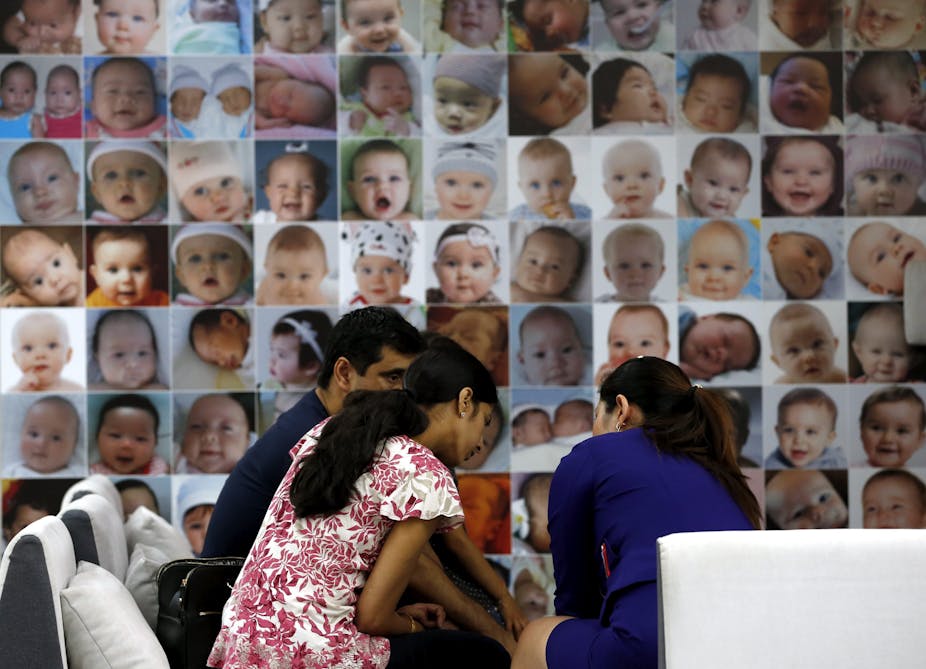Often emphasised in discussions about children’s best interests is the idea that certain ways of having and raising children are “natural”. For example, this word appears frequently in reference to how children are conceived (with heterosexual intercourse often referred to as “natural reproduction”). It also appears in reference to how children are raised (e.g. it is typically seen as “natural” for a child to have a mother and a father).
Views on what is “natural” have had a predictable airing in public debate over commercial surrogacy as a result of two recent cases of babies being abandoned by intended parents first in Thailand and now in India. Legislating for commercial surrogacy in Australia would help avoid this type of outcome. One barrier to the implementation of such legislation, however, is the view that commercial surrogacy is “unnatural”.
Natural or naturalised?
To progress discussions about children’s best interests beyond claims about what is “natural”, it is useful to consider the word as a moral category. In other words, what is referred to as “natural” is determined by human beings, rather than simply reflecting the world around us. This approach can help us to see that often what is described as “natural” in regard to the conception, birth and raising of children is what in fact has been “naturalised”, rather than strictly what is “in nature”.
So, for example, heterosexual intercourse doesn’t occur absent of a whole range of factors that are not, technically speaking, “in nature”. This includes how we present ourselves to others (e.g. clothing, grooming, scents), how we meet people (such as on dating sites) and the contexts in which heterosexual intercourse may occur (in buildings, for example). None of these is natural in the true sense.
Similarly, births that result from heterosexual intercourse are not strictly speaking “natural”. They often take place in hospitals, with the assistance of highly qualified professionals, and for some people with the use of medication and/or surgery. Again, we would find none of this in nature.
We can see, then, that what is treated as “natural” is actually “naturalised”; it is what has become part of our nature as people living in a country such as Australia.
These points about what is considered “natural” are important when we come to topics that are at times depicted as unnatural. For example, a public debate is under way in Australia about commercial surrogacy. As a mode of conceiving and birthing children, commercial surrogacy is often (though not always) depicted as unnatural and thus not in the best interests of children.
Birth rate and ageing affect us all
The problem we face in Australia, however, is a declining birth rate (below replacement rate) and an ageing population. Australian citizens are thus encouraged to reproduce in order to ensure the future wellbeing of the nation and its citizens. If such a pro-natalist approach is important, then we must acknowledge that fulfilling population targets requires a wide range of options in terms of the conception and birth of children.

Over the past decade reproductive technologies have become available to a much wider range of people. This has required legislative change to allow access for groups of people who, in the past, would have been considered “unnatural”.
What is now required are legislative changes that again revisit how we determine the borders of what is considered “natural”, this time to acknowledge that the nation is best off regulating its citizens within its borders, rather than accepting a status quo that implicitly encourages people to travel abroad for access to reproductive technologies (such as commercial surrogacy). This would certainly be in the best interests of all parties, including women in countries outside of Australia who at present act as commercial surrogates for Australian citizens, a situation that is largely beyond the regulatory purview of Australia.
Legislation is in everyone’s best interests
Legislating for commercial surrogacy within Australia would allow for the tight regulation of surrogacy arrangements, which would include ensuring the safety of women who act as surrogates, and the keeping of records so that into the future children can find information about all involved in their conception and birth.
Just as the significant institutional supports for the birth of children conceived via heterosexual intercourse have been naturalised (e.g. hospitals, paid parental leave and medical science), so too, it is suggested here, should commercial surrogacy be naturalised as yet another way of having children.
Importantly, it is not argued that commercial surrogacy should become privileged as a way of having children.
Legislative change in the child protection sector is needed too, so that more children who cannot live with their birth parents can be raised by other people wishing to have children, under permanent arrangements. Like discussions about commercial surrogacy, discussions about changes to the child protection sector also require us to rethink what we consider “natural” in terms of having and raising children.
For some, raising “another person’s child” might seem unnatural. For others, it might seem unnatural to separate a child from their birth parents. And for yet others, it might seem unnatural to encourage relationships between the multiple parents involved in raising a child in the context of child protection.
As this piece has suggested, for us to truly progress conversations about children’s best interests in Australia, it is important that we widen our scope in terms of what we see as “natural”.

